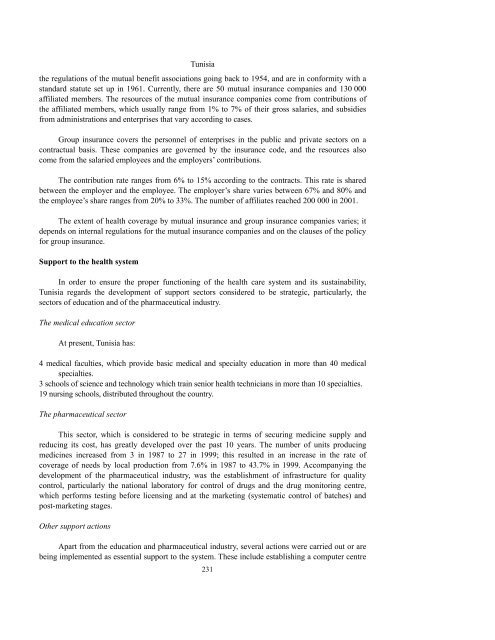The role of contractual arrangements in improving health sector ...
The role of contractual arrangements in improving health sector ...
The role of contractual arrangements in improving health sector ...
Create successful ePaper yourself
Turn your PDF publications into a flip-book with our unique Google optimized e-Paper software.
Tunisia<br />
the regulations <strong>of</strong> the mutual benefit associations go<strong>in</strong>g back to 1954, and are <strong>in</strong> conformity with a<br />
standard statute set up <strong>in</strong> 1961. Currently, there are 50 mutual <strong>in</strong>surance companies and 130 000<br />
affiliated members. <strong>The</strong> resources <strong>of</strong> the mutual <strong>in</strong>surance companies come from contributions <strong>of</strong><br />
the affiliated members, which usually range from 1% to 7% <strong>of</strong> their gross salaries, and subsidies<br />
from adm<strong>in</strong>istrations and enterprises that vary accord<strong>in</strong>g to cases.<br />
Group <strong>in</strong>surance covers the personnel <strong>of</strong> enterprises <strong>in</strong> the public and private <strong>sector</strong>s on a<br />
<strong>contractual</strong> basis. <strong>The</strong>se companies are governed by the <strong>in</strong>surance code, and the resources also<br />
come from the salaried employees and the employers’ contributions.<br />
<strong>The</strong> contribution rate ranges from 6% to 15% accord<strong>in</strong>g to the contracts. This rate is shared<br />
between the employer and the employee. <strong>The</strong> employer’s share varies between 67% and 80% and<br />
the employee’s share ranges from 20% to 33%. <strong>The</strong> number <strong>of</strong> affiliates reached 200 000 <strong>in</strong> 2001.<br />
<strong>The</strong> extent <strong>of</strong> <strong>health</strong> coverage by mutual <strong>in</strong>surance and group <strong>in</strong>surance companies varies; it<br />
depends on <strong>in</strong>ternal regulations for the mutual <strong>in</strong>surance companies and on the clauses <strong>of</strong> the policy<br />
for group <strong>in</strong>surance.<br />
Support to the <strong>health</strong> system<br />
In order to ensure the proper function<strong>in</strong>g <strong>of</strong> the <strong>health</strong> care system and its susta<strong>in</strong>ability,<br />
Tunisia regards the development <strong>of</strong> support <strong>sector</strong>s considered to be strategic, particularly, the<br />
<strong>sector</strong>s <strong>of</strong> education and <strong>of</strong> the pharmaceutical <strong>in</strong>dustry.<br />
<strong>The</strong> medical education <strong>sector</strong><br />
At present, Tunisia has:<br />
4 medical faculties, which provide basic medical and specialty education <strong>in</strong> more than 40 medical<br />
specialties.<br />
3 schools <strong>of</strong> science and technology which tra<strong>in</strong> senior <strong>health</strong> technicians <strong>in</strong> more than 10 specialties.<br />
19 nurs<strong>in</strong>g schools, distributed throughout the country.<br />
<strong>The</strong> pharmaceutical <strong>sector</strong><br />
This <strong>sector</strong>, which is considered to be strategic <strong>in</strong> terms <strong>of</strong> secur<strong>in</strong>g medic<strong>in</strong>e supply and<br />
reduc<strong>in</strong>g its cost, has greatly developed over the past 10 years. <strong>The</strong> number <strong>of</strong> units produc<strong>in</strong>g<br />
medic<strong>in</strong>es <strong>in</strong>creased from 3 <strong>in</strong> 1987 to 27 <strong>in</strong> 1999; this resulted <strong>in</strong> an <strong>in</strong>crease <strong>in</strong> the rate <strong>of</strong><br />
coverage <strong>of</strong> needs by local production from 7.6% <strong>in</strong> 1987 to 43.7% <strong>in</strong> 1999. Accompany<strong>in</strong>g the<br />
development <strong>of</strong> the pharmaceutical <strong>in</strong>dustry, was the establishment <strong>of</strong> <strong>in</strong>frastructure for quality<br />
control, particularly the national laboratory for control <strong>of</strong> drugs and the drug monitor<strong>in</strong>g centre,<br />
which performs test<strong>in</strong>g before licens<strong>in</strong>g and at the market<strong>in</strong>g (systematic control <strong>of</strong> batches) and<br />
post-market<strong>in</strong>g stages.<br />
Other support actions<br />
Apart from the education and pharmaceutical <strong>in</strong>dustry, several actions were carried out or are<br />
be<strong>in</strong>g implemented as essential support to the system. <strong>The</strong>se <strong>in</strong>clude establish<strong>in</strong>g a computer centre<br />
231
















